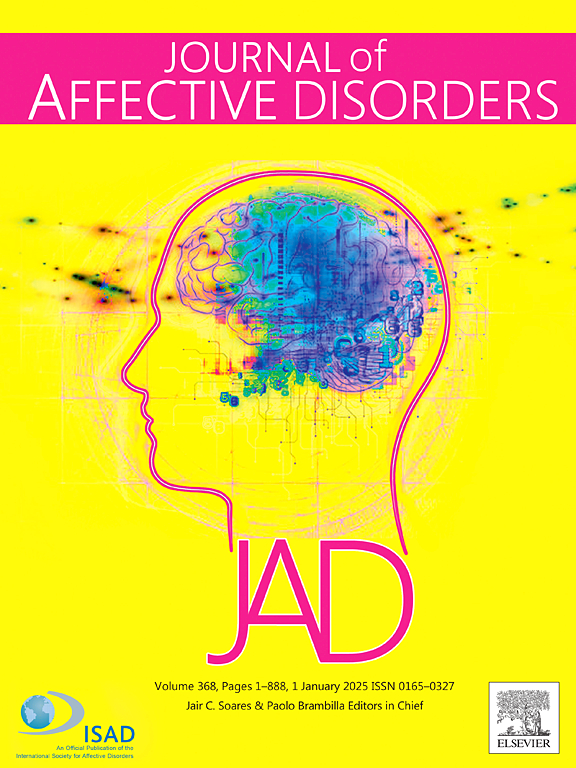Depression is associated with treatment response trajectories in adults with Prolonged Grief Disorder: A machine learning analysis
IF 4.9
2区 医学
Q1 CLINICAL NEUROLOGY
引用次数: 0
Abstract
Background
Although evidence-based Prolonged Grief Disorder treatments (PGDT) exist, pretreatment characteristics associated with differential improvement remain unidentified. To identify clinical factors relevant to optimizing PGDT outcomes, we used unsupervised and supervised machine learning to study treatment effects from a double-blinded, placebo-controlled, randomized clinical trial.
Methods
Patients were randomized into four treatment groups for 20 weeks: citalopram with grief-informed clinical management, citalopram with PGDT, pill placebo with PGDT, or pill placebo with clinical management. The trial included 333 PGD patients aged 18–95 years (M = 53.9; SD = 14.4). Symptom trajectories were assessed using latent growth mixture modeling based on Inventory for Complicated Grief scores collected every 4 weeks. The relationship between patient-level characteristics and assigned trajectories was examined using logistic regression with elastic net regularization based on the administration of citalopram, PGDT, and risk factors for developing PGD.
Results
Three response trajectories were identified: lesser severity responders (60 %, n = 200), greater severity responders (18.02 %, n = 60), and non-responders (21.92 %, n = 73). Significant differences between greater severity responders and non-responders emerged by Week 8, persisting through the 6-month follow-up assessment. The elastic net model (AUC = 0.702; F1 = 0.777) indicated that higher baseline depression severity, grief-related functional impairment, and not receiving PGDT were associated with a decreased probability of response.
Limitations
An independent validation cohort of PGDT patients is needed to further study generalizability of findings.
Conclusions
Differential PGDT courses and the role of depression severity and grief-related functional impairment in treatment non-response were identified. These findings underscore the importance of determining clinical factors relevant to optimizing individual treatment strategies.
抑郁症与成人长期悲伤障碍的治疗反应轨迹相关:一项机器学习分析
背景:尽管存在循证延长悲伤障碍治疗(PGDT),但与差异改善相关的预处理特征仍未确定。为了确定与优化PGDT结果相关的临床因素,我们使用无监督和有监督机器学习来研究双盲、安慰剂对照、随机临床试验的治疗效果。方法:患者被随机分为四个治疗组,为期20 周:西酞普兰与悲伤知情的临床管理,西酞普兰与PGDT,药丸安慰剂与PGDT,或药丸安慰剂与临床管理。该试验纳入333例年龄为18-95 岁的PGD患者(M = 53.9;SD = 14.4)。症状轨迹评估使用基于复杂悲伤量表评分的潜在生长混合模型每4 周收集一次。基于西酞普兰、PGDT和发生PGD的危险因素,使用弹性网正则化的逻辑回归来检验患者水平特征与分配轨迹之间的关系。结果:三种响应轨迹确定:较小的严重性反应(60 % n = 200),更严重的反应(18.02 % n = 60),无(21.92 % n = 73)。严重反应者和无反应者之间的显著差异在第8周出现,持续到6个月的随访评估。弹性网模型(AUC = 0.702;F1 = 0.777)表明,较高的基线抑郁严重程度、悲伤相关的功能障碍和未接受PGDT治疗与反应概率降低相关。局限性:需要一个独立的PGDT患者验证队列来进一步研究结果的普遍性。结论:确定了不同的PGDT病程以及抑郁严重程度和悲伤相关功能障碍在治疗无反应中的作用。这些发现强调了确定与优化个体治疗策略相关的临床因素的重要性。
本文章由计算机程序翻译,如有差异,请以英文原文为准。
求助全文
约1分钟内获得全文
求助全文
来源期刊

Journal of affective disorders
医学-精神病学
CiteScore
10.90
自引率
6.10%
发文量
1319
审稿时长
9.3 weeks
期刊介绍:
The Journal of Affective Disorders publishes papers concerned with affective disorders in the widest sense: depression, mania, mood spectrum, emotions and personality, anxiety and stress. It is interdisciplinary and aims to bring together different approaches for a diverse readership. Top quality papers will be accepted dealing with any aspect of affective disorders, including neuroimaging, cognitive neurosciences, genetics, molecular biology, experimental and clinical neurosciences, pharmacology, neuroimmunoendocrinology, intervention and treatment trials.
 求助内容:
求助内容: 应助结果提醒方式:
应助结果提醒方式:


